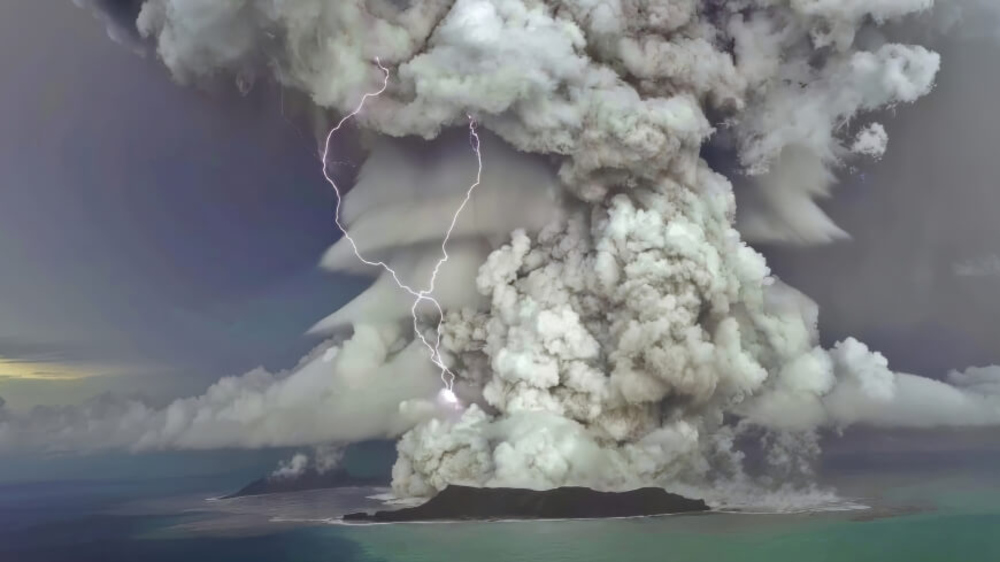On January 15, 2022, the South Pacific witnessed the explosive eruption of the Hunga Tonga-Hunga Ha’apai (HTHH) volcano. This event was not only a geological marvel but also an atmospheric anomaly, with a shock wave that reverberated globally. It was more than just a volcanic eruption; it was a phenomenon that significantly altered the Earth’s stratospheric chemistry.
Table of Contents
- Record-Breaking Stratospheric Disturbance
- Global Spread and Impact on the Ozone Layer
- A Detailed Analysis Using Advanced Technology
- Chemical Reactions and Atmospheric Changes
- The Peak of Ozone Depletion
- Future Research and Long-Term Implications
- Bottom Line
Record-Breaking Stratospheric Disturbance
The eruption’s most notable achievement was the unprecedented injection of water vapor into the stratosphere, a layer 8 to 30 miles above Earth. About 300 billion pounds of water were thrust into this typically dry region, raising global water vapor levels in the stratosphere by approximately 10%. Such a significant increase had never been observed before in the satellite era, making this event a benchmark in atmospheric science.
Global Spread and Impact on the Ozone Layer
The impact of this eruption extended far beyond its geographic location. The majority of the injected water vapor, about 78%, concentrated in the Southern Hemisphere. This dramatic change in water vapor distribution led to a cooling effect in the stratosphere and significant reductions in stratospheric column ozone. Ozone, crucial for protecting life from harmful ultraviolet radiation, saw unprecedented losses of up to 7% over large areas of the Southern Hemisphere.
Similar Posts
A Detailed Analysis Using Advanced Technology
The research team, led by David Wilmouth and Ross Salawitch, used NASA’s Microwave Limb Sounder on the Aura satellite to meticulously track the spread of water vapor and monitor changes in the stratospheric composition. This detailed observation provided invaluable insights into the dynamics of volcanic impacts on the atmosphere. Wilmouth noted, “We’ve never seen, in the history of satellite records, this much water vapor injected into the atmosphere,” highlighting the event’s exceptional nature.
Chemical Reactions and Atmospheric Changes
The presence of increased sulfate aerosols from the volcano facilitated new surfaces for chemical reactions. These reactions, combined with the additional water vapor, set off a series of events leading to widespread changes in the concentrations of various compounds, including ozone. The eruption altered not just the chemistry but also the dynamics of the stratosphere, leading to reduced ozone levels in the Southern Hemisphere and an increase over the tropics.
The Peak of Ozone Depletion
The most significant decrease in ozone occurred in October 2022, nine months after the eruption. This peak in depletion was a direct result of the enormous increase in water vapor and sulfate in the stratosphere. Wilmouth explained, “We had this enormous increase in water vapor in the stratosphere with modest increases in sulfate that set off a series of events that led to significant changes in temperature and circulation, ClO, HNO3, HCl, O3, and other gases”.
Future Research and Long-Term Implications
The team is poised to continue their study, tracking the impact of the volcano into 2023 and beyond. The lingering high levels of water vapor in the stratosphere are expected to amplify ozone losses in the Antarctic. This long-term presence of elevated water vapor poses potential risks for the ozone layer, warranting continuous observation and study.
Bottom Line
The HTHH eruption serves as a powerful reminder of the fragile interconnectedness of Earth’s atmospheric systems. It has provided scientists with a unique opportunity to study the long-term effects of volcanic activity on the ozone layer and atmospheric chemistry. As researchers delve further into this data, their findings will significantly enhance our understanding of the Earth’s atmospheric dynamics and its susceptibility to natural events.

















